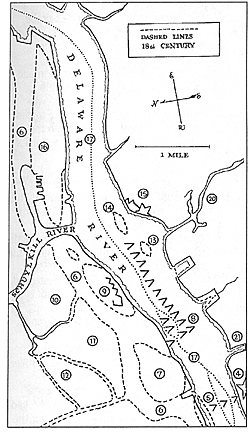MWAN Contributing Editor Robert Haworth submits the following large hypothetical American War of Independence (AWI) scenario.
SUMMARY
Turns: 12
Patriot Players: 2-3
British Players: 2
Attackers: Patriots
Men: Fig.: 20:1
Total Figures
- Foot: 487
Mtd: 10
Cdr: 9
Guns: 8
 BACKGROUND
BACKGROUND
On 22 October 1777, a 1,200-man Hessian infantry brigade was decisively defeated in its attempt to storm a little earth-walled rebel fort overlooking the Delaware River at Red Bank (near present-day Woodbury), New Jersey. The 400 Patriot defenders of "Fort Mercer", led by a distant relative of Continental MG Nathaniel Greene, noted the Hessian commander's contempt for them and goaded that officer into ordering a charge. It proceeded straight into the mouths of several masked artillery pieces firing grapeshot, as well as sheets of close-range musket fire. Three shattered Hessian regiments reeled back from the parapet; the gathering dusk and heavy officer casualties meant that they could not be reorganized for another assault. Instead, they limped off toward their starting point at Cooper's Ferry (now Camden), NJ.
Just 37 Americans had been killed or wounded during the 40-minute affair, while somewhat over 500 Hessians had been lost. Hessian killed and wounded were "at least 375", with perhaps 120 more captured (some found clinging, paralyzed with fear, to the face of the rebel parapet) or deserted during the Germans' painfully slow, militia-harassed retreat.
In the confusion the Hessians left behind them their fatally injured commander, COL Count Karl Emil Ulrich von Donop. Donop was riddled with 13 musket balls while urging his men over the fort's main wall. He lingered in agony for three days before succumbing, and was buried near the works. His last words reportedly were, I die a victim of my own ambition, and of the avarice of my Sovereign." Col. von Donop had been anxious to revenge the Hessian defeat at Trenton the previous December, for which a whispering campaign had since held him partially responsible. This insult to his honor may have helped lead him to make the attack at 4:45 PM in failing light, having prepared no scaling ladders and without waiting for promised British naval gunfire support-by contrast, fire from three rebel river galleys supported the northern end of the works during the battle. Finally, Donop had arranged only a token artillery preparation using the two 12-pounders he had brought along.
As a final blow, two British men-of-war which had attempted to come to the Hessians' aid went aground, and were soon punished by oven-heated shot from the fort. One of these ships, the 64-gun Augusta, caught fire and blew up.
In reaction to the Red Bank debacle the British captured Billingsport (Point "4" on the map), a few miles from Ft. Mercer, on 27 October. They then proceeded to reduce Ft. Mifflin (Point 9) - the linchpin of the river defense on the Pennsylvania side --- in a siege stretching from 10-16 November.
 On 17 November, they landed MG Thomas Wilson's division at Billingsport with the intention of attacking Red Bank again. Wilson was succeeded in command the next day when an
additional division under LTG Cornwallis arrived. The combined British force was assigned to clear the New Jersey bank of the Delaware of rebel forts, artillery batteries, and safe harbors for the small but annoying Pennsylvania State Navy, thus enabling the British in Philadelphia to be resupplied by water during the last few weeks of ice-free navigation.
On 17 November, they landed MG Thomas Wilson's division at Billingsport with the intention of attacking Red Bank again. Wilson was succeeded in command the next day when an
additional division under LTG Cornwallis arrived. The combined British force was assigned to clear the New Jersey bank of the Delaware of rebel forts, artillery batteries, and safe harbors for the small but annoying Pennsylvania State Navy, thus enabling the British in Philadelphia to be resupplied by water during the last few weeks of ice-free navigation.
Meanwhile, at Fort Mercer (Point 15), LTC Christopher Greene pondered his chances. He had received word that Morgan's Rifle Corps and several other regiments from MG Gates's victorious Northern Army had finally been sent south from Saratoga, NY toward Washington's camp at Whitemarsh, PA, but that Washington planned to divert these units to Woodbury to assist him. BG Charles Varnum was at nearby Gloucester with his own brigade of Continental regulars, and a shifting force of militia might be counted on help make a stand. No one had a real idea as when Gates' reinforcements would arrive, however, and without them the enemy would outnumber the locally-available Patriot forces by a factor of several to one.
After three days of indecision, made the more agonizing by a flurry of contradictory intelligence and official promises of support, LTC Greene sent most of his garrison away to Woodbury and prepared to blow up Fort Mercer. A handful of volunteers spiked the artillery and poured gunpowder over every square yard of the works, then lit the match the next day when they (falsely) believed that British landing craft were heaving-to on the misty riverbank nearby. Cornwallis's Light Infantry captured the ruined fort without a fight a couple of hours later.
The British vanguard started toward Red Bank on 20 November, followed the next day by the main body. Washington sent Varnum all the support he practically could, but the assembled Americans were able to do nothing more than skirmish with British outposts at Red Bank (26 November) before learning that the fort itself had already been destroyed on the morning of the 21st. Thereupon the Americans drew off: with the exception of MG Greene's probe against a British camp at Gloucester Point a few days later, both sides curtailed operations in southern New Jersey for the year.
This scenario posits that Gates's regiments departed Saratoga earlier (or made better time on their way south), and that all but Paterson's were available to coordinate a surprise attack on the British raiders in concert with the (newly besieged) Red Bank garrison. The British order of battle (OB) shows the forces historically present in their expedition, arrayed in a logical manner given the missions of each component. The Patriot OB gives MG Greene the same forces and scheme of deployment he used at Gloucester Point.
Back to MWAN #114 Table of Contents
Back to MWAN List of Issues
Back to MagWeb Magazine List
© Copyright 2001 Hal Thinglum
This article appears in MagWeb (Magazine Web) on the Internet World Wide Web.
Other military history articles and gaming articles are available at http://www.magweb.com